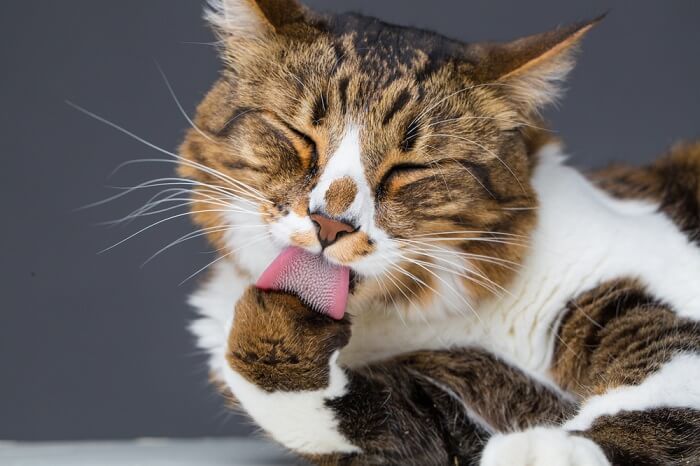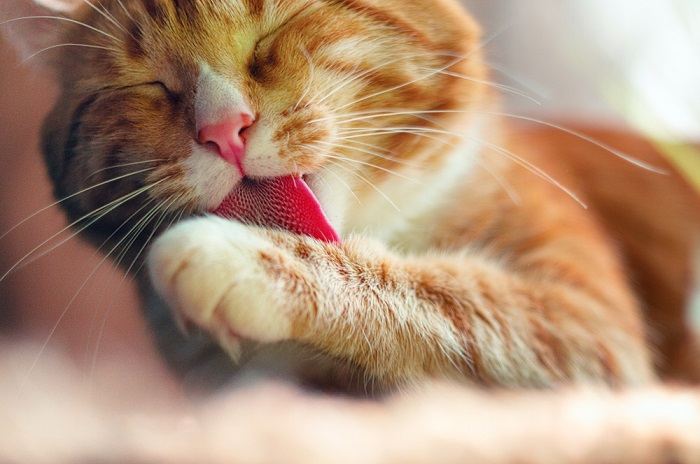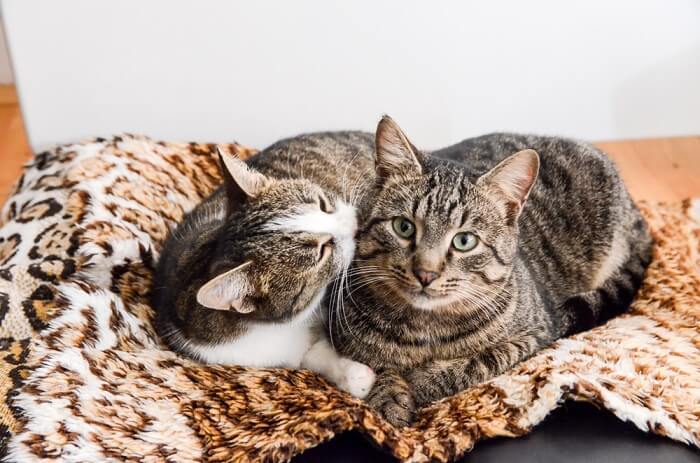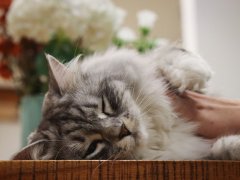
“She’s at it AGAIN! Licking, licking, licking, and pulling and chewing and nibbling. Why won’t she stop? No matter how many times I tell her to stop, she just goes back to it! What’s wrong with her?”
Self-grooming is an activity that cats spend a lot of their time doing. In fact, as much as 30-50% of their waking hours are spent fastidiously cleaning themselves.
There is often a little sequence that they follow, starting with one particular spot, moving on to the next in a fairly fixed order. They’re more likely to groom just before going to sleep, after they wake -up, after a meal or snack, and sometimes in-between times if they’ve been in the rain or had a roll in the leaves.
This is part of being a cat. But what happens when they’re grooming more often, with greater intensity, or for a longer duration?
What Is Compulsive Grooming in Cats?

As with many behavioural signs, there can be many compounding factors including underlying physical issues and medical problems, like a flea infestation, allergies, joint pain, abdominal discomfort amongst others, that need to be investigated. So, it is always important to discuss changes in grooming behaviour with your veterinarian.
If there are no obvious physical abnormalities, then we need to consider emotional and mental health components, which, too, are medical issues. And in cats, emotional and social stress and distress can manifest as a displacement behaviour (a “fiddle” or “fidget” behaviour). Repetitive grooming is one of those displacement behaviours.
So When Does Repetitive Grooming Become a Compulsive Disorder?

It can be a challenge to differentiate between normal grooming and compulsive or repetitive grooming behavior.
A compulsive disorder is when an animal feels the overwhelming urge to perform a behaviour over and over again. These behaviours often form part of an animal’s normal behaviour repertoire, but start to be performed with increasing frequency, intensity or duration and are often inappropriate for the context in which they’re occurring.
In addition, the performance of these behaviours begins to interfere with the animal being able to do other normal activities and subsequently decreases their quality of life. Initially, these behaviors may occur in response to stressors, but may eventually develop into behaviors that occur spontaneously on their own.
There may be components of unwanted thoughts or sensations, as we see in people with Obsessive Compulsive Disorder (OCD), but because we can’t ask cats what they’re thinking (or at least, they can’t tell us in words), so in Veterinary medicine, we will often use the term “Compulsive Behaviors” although owners may describe it as obsessive grooming.
An important factor of these behaviours is that neither animals nor people feel like they want to do these things, but rather they “have to” and have no power to stop. So, it’s important to try to not get angry or annoyed, but rather understand that your cat is definitely not doing this “on purpose”.
Signs of Repetitive and Compulsive Grooming:
- Is your cat spending a really long time grooming? Is it over-grooming a particular area?
- Does it perform this behaviour over and over again in a very fixed pattern?
- Are you able to get your cat’s attention? Or is it difficult to interrupt?
- Does it perform this behaviour at times when you wouldn’t expect it to be doing it?
- Does it occur more often than you would expect?
- Has your cat stopped doing things that it used to enjoy?
- Is your cat experiencing hair loss, small bald patches, or large areas of baldness?
- Is your cat vomiting fur or bringing up hairballs?
- Are there skin lesions such as crusts, wounds, or abrasions?
- Is your cat otherwise more anxious or fearful than it used to be?
- Is your cat spending more time hiding?
- Are there other new behaviours that your cat is showing e.g. urine marking or spraying?
- Litter box issues? Not wanting to use the tray or crying when trying to use the tray?
- Problems with other pets or people in the household?
- Are there changes in sleep or activity?
- Does the behavior appear to be stress-related?
- Is your cat aggressively attacking itself or someone else?
- Is the behaviour causing injury, bite wounds, or mutilations?
If you have said yes to any of these questions, or are otherwise concerned about your cat, it’s worth having a chat with your veterinarian.
Common Causes of Repetitive Grooming

As already mentioned, there are many reasons why cats groom more than usual.
Here are some of the medical causes which may be involved, but this is by no means an exhaustive list:
- Flea Infestation
- Atopic or Allergic Skin Disease, including some food allergies
- Fungal Infections (Ringworm)
- Degenerative Joint Disease (Arthritis)
- Autoimmune and Hypersensitivity Disorders (e.g. Eosinophilic Granuloma Complex)
- Hyperthyroidism
- Feline Hyperaesthesia (Rolling Skin Disease)
- Skin Cancers or Other Cancers that have spread to the skin
- Generalised or Situational Anxiety (e.g. Separation Anxiety)
- Psychogenic Alopecia
- Compulsive Disorder
Treatment of Compulsive Grooming in Cats

The treatment of your cat’s compulsive grooming will depend on the symptom’s underlying cause.
Treatment is aimed at addressing the underlying cause. Overgrooming is just a ‘clinical sign’ like we discuss ‘symptoms’ as people. It is not a diagnosis. So, it is really important that the behaviour is investigated in a methodical fashion and treated like other medical conditions.
A behavioural diagnosis is usually reached by providing your vet with as much information about the grooming behaviour as possible, eliminating physical issues as reasons, and making detailed behavioural observations (whether in person or recorded on video).
Sometimes these behaviours may be very complex and have components of both physical and mental health disorders.
Sometimes, it may be necessary for your cat to be seen by a Behaviour Vet or Veterinary Behaviour Specialist, a Veterinary Dermatologist and/or an Internal Medicine Specialist in order to reach a diagnosis and start appropriate treatment.
What is important to remember is that the sooner you seek help for your pet, the better.
The longer a complex overgrooming issue continues, the longer it takes to improve or resolve.
When a Behavioural Disorder diagnosis is made, treatment may involve:
- Environmental Management: Making sure that your cat’s living circumstances are “cat friendly”
- Behaviour Modification: Including exercises that help reduce stressors; increase relaxation and calm; and other behavioral outlets that use more of their time budget, allow them perform a wider variety of normal behaviours and enable them to cope better (e.g. enrichment activities and playtime).
- Medication: Sometimes cats are prescribed anti-anxiety medication to help a pet manage anxiety, disproportionate fear, abnormal neurological sensations, or compulsive behaviours. Just like other chronic medical conditions such as diabetes and kidney or heart disease, some pets may need to stay on medication life-long. Other supports may include pheromones (like Feliway spray or diffuser) and supplements.
- Monitoring: Behavioural issues may take time to resolve and don’t usually improve overnight. Monitoring is an important way of being able to objectively evaluate whether strategies are effective in improving a condition or not; if there are new triggers that set off the behaviour; and to predict times in the future when your pet may need a little extra support.
Read More: Cat Separation Anxiety: Causes, Symptoms, And Treatment
Prevention

Some behavioural conditions have a genetic component to them, so there may not always be a way to prevent the condition from developing, but there will certainly be ways to help prevent exacerbation of the clinical signs.
Your vet will give you information on this, depending on the diagnosis that is made. General ways to decrease your cat’s stress are to:
- Keep your cat up-to-date with external parasite preventatives.
- Ensure litter box hygiene, location, size, number, litter type, etc. are all appropriate for your cats and household.
- Make sure your cat has adequate areas to rest and sleep in.
- Protect your cat from constant exposure to triggers that make him or her feel anxious or fearful.
- Make sure your cat always has access to water and food in several different areas.
Conclusion

Yes, cats spend a lot of time grooming! And often it’s an activity that they seem to enjoy – a little like us going to the spa. However, if you notice changes in your cat’s grooming patterns, it is important not to ignore them.
There are many different reasons for these changes, and you should discuss your concerns with your vet. She can help you and your little buddy feel better again.
Frequently Asked Questions
How do I get my cat to stop over grooming?
There can be many reasons for your cat overgrooming. These can range from skin parasites, infections, allergic and autoimmune disease to cancer and behavioural issues. You can try engaging your cat in a game, calling its name, offering it a scratch or a brush. If these options don’t help, it’s best to get your cat checked out by a vet so that they can help diagnose any underlying causes.
What is considered excessive grooming in cats?
Cats may spend up to 30-50% of their waking hours grooming. If you’re noticing a change in the frequency or duration that your cat is grooming; or there is damage to its coat or skin; or your cat is grooming instead of doing other things it usually enjoys doing (e.g. playing or interacting) it’s worth chatting to your vet about.
What causes cats to lick excessively?
There are many reasons why cats may lick including: skin disorders, gastrointestinal issues, autoimmune issues, pain or inflammation. Licking can also be a displacement behaviour i.e. a fiddle or fidget behaviour that cats do when they’re nervous or fearful.
Excessive licking and grooming can also be part of neurological and behavioural disorders like hyperaesthesia syndrome and compulsive disorders.
Why is my cat obsessed with grooming?
Repetitive behaviours can become compulsive disorders. These are behaviours that cat feels compelled to do. These are not behaviours that a cat does ‘on purpose’ but rather because it feels it can’t stop, much in the way people with obsessive compulsive disorder feel.
Try not to get angry or frustrated with your cat, but do seek help from your GP vet, a Behaviour Vet or a Veterinary Behaviour Specialist.
-
“Feline Behavioral Health and Welfare” 2016 Edited by S. Heath & I. Rodan
-
Cornell: Cats that Lick Too Much | Cornell University College of Veterinary Medicine
-
Veterinary Information Network: Feline Obsessive-Compulsive Disorders - WSAVA 2001 - VIN
-
iCatCare: Handling your cat for grooming - YouTube and Performing a health examination - YouTube








My cat has chewed all the hair off her stomach and back legs…we have a multi-cat household. She was a feral that we socialized, she is scared of loud noise, deathly afraid of storms and isolates most of the time. She is friendly and loving when she gets in the bed with me…I have taken her to the vet and they found her blood work to be normal and offered no real solution. Should I try different vet because her licking and hair loss are getting worse by the day??? I appreciate any advise you could provide…Thank you.
I can’t say if you should switch vets, but you may find that a vet with more of a focus on feline behavior and psychological health may be better equipped to go beyond standard testing. This very much sounds like a stress-related issue, and you’ll find many resources that will help you to address that. This article shares the signs of stress and a few tips to help you resolve it. Wishing you and your cat all the best!
Hello,
I’m not sure my cat has an obsession with grooming, but he is thorough.
My issue is he is getting bald spots on the backs of his ears. Not sure what that is about.
I’m assuming it is an allergy, but have you heard of this being a sign of anything specific?
Thank you.
Lorien
Hi Lorien, It’s best to get him checked by your vet. There are a variety of issues that can cause bald patches and your vet will be able to examine him and ask you specific questions to rule certain conditions in or out.
Thank you for this article as my cat has been diaganosed with hyperthyriodism and my vet didnt think the overgrooming was associated with this condition. . but now I know it does
Hi Jennifer, yes, can be related to hyperthyroidism but can also be anxiety-related. If you don’t see an improvement, please get in touch with your vet.
Thank you for these important emails. I always check the website and read the articles. Stay safe.